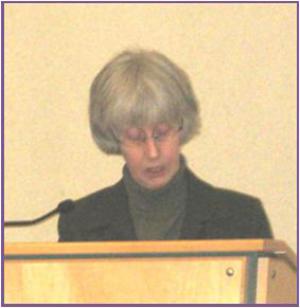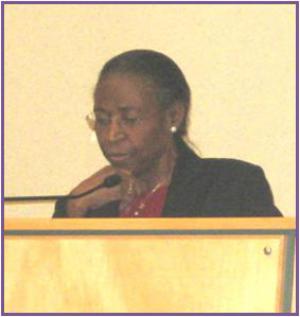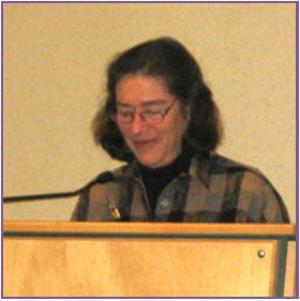Women In Print 2013



Despite the rain and wind on the evening of March 6, 2013, 45 people attended the tenth annual WOMEN IN PRINT, held in the Saxe Room at the Worcester Public Library. The evening began with an introduction by Dianne Bruce, WWHP Vice President. After reminding the audience that March is membership renewal month for WWHP and Women’s History Month, Ms. Bruce introduced the first author, Katherine Keenum, who holds a Ph.D. in Medieval Studies from University of Texas.
Dr. Keenum began with a story about how her great-grandmother was expelled from Vassar for helping her friend elope in the 1870s. Dr. Keenum found out about this by finding an article, but she could not find any letters or diary entries on this topic. Finding the article made her wonder two basic things about her great-grandparents. The first was how did they meet? Dr. Keenum’s great-grandfather was a Civil War veteran and twenty years older than her great-grandmother, who was a young, spunky artist. The second thing Dr. Keenum wondered was what was it like in the 1870s? These two questions spurred on Dr. Keenum to write the historical fiction novel, Where the Light Falls, as a serious exploration of the art world in Paris in the 1870s.
Dr. Keenum focused her novel on Jeannette Palmer, her great-grandmother. The novel opens with the expulsion from Vassar. In the novel, it was recommended by Jeannette’s professor that she go to Paris to study art, but with the warnings “use common sense, don’t make mistakes” and “when an artist gives up a career, somewhere an angel weeps.” At this point, Jeannette, who is originally from Ohio, goes to New York City with a letter of reference from this professor from Vassar in the hopes of being trained by various art teachers, including Mary Cassatt’s teacher. Later, Jeannette travels to Paris with her cousin, Effie. Dr. Keenum mentioned that Effie was an “invented spinster cousin”, who plays the role of third main character in the novel beside the heroine Jeannette and Jeannette’s love interest, Edward. While in Paris, Jeannette studies under a very prestigious artist at Academy Julian, in spite of the very expensive tuition. In her research, Dr. Keenum discovered that the tuition fees women paid were twice what men paid. She also mentioned using a book written by May Alcott (sister of Louisa May Alcott) to find out where to buy art supplies in Paris in the 1870s. This book “gave texture and immediacy to a novel.” Dr. Keenum also looked at letters May Alcott sent to Louisa May Alcott from Paris, claiming “It’s a way of living the experience and does have historical value.”
The second author of the evening was Edna P. Spencer. In her introduction of Ms. Spencer, Dianne Bruce highlighted that she is the first black woman to serve as President of the YWCA of Worcester and the first black woman to serve as Chair of Trustees of Quinsigamond Community College, among other accolades. Ms. Spencer is a Worcester native and a graduate of Clark University. Ms. Spencer began her talk by mentioning how people no longer write letters, unlike in previous generations. . “Slaves wrote letters, even though they weren’t supposed to.” she said. Ms. Spencer’s great-grandfather was born during the time of slavery, but was free and owned land in Oakridge, Tennessee, where Ms. Spencer was born.
When the Tennessee Valley Association was established in the 1930s, this land was taken away, which caused Ms. Spencer’s family to migrate north to Worcester. This migration is documented in Ms. Spencer’s book What Color Is the Wind. Ms. Spencer read a section from the book about her family home in Oakridge, which was so descriptive that I felt as though I were there. It was a warm recollection of her home, but Ms. Spencer admitted farm life was hard. Her father died young and her mother went to Worcester, remarried, and then sent for Ms. Spencer to join her at the age of six. Sadly, Ms. Spencer’s mother died when she was nine and she went to live with relatives in Upton who were not very welcoming. However, Ms. Spencer said her family made the Worcester community their home and contributed to the community through their work, serving in the military, and becoming involved in the neighborhood and the church. She closed her talk by reading the following passage from her book, “They chisled out places in the neighborhood: sent their sons to war, ran their businesses, and raised their children.”
Dianne Bruce introduced the final author of the evening, Elizabeth Fideler. She mentioned that Ms. Fideler’s book Women Still At Work - Professionals Over Sixty And On the Job stems from her research which focuses on men and women who choose to work beyond traditional retirement age. Ms. Fideler is a Framingham resident, chairs the Framingham Library’s Board of Trustees, and is a research fellow at Sloan Center on Aging and Work at Boston College. Ms. Fideler mentioned how timely it was to be speaking on the topic of working women, since it was the fiftieth anniversary of Betty Friedan’s The Feminist Mystique, Women’s History Month, and the one-hundreth anniversary of women suffragettes’ march on Washington, DC.
Ms. Fideler became interested in her topic when she reached age 65, when the grant that paid her salary ran out, and she still wanted to keep working. She was interested in researching women still in the workforce after age 60. Through the Bureau of Labor Statistics, she found that the fastest growing segment of the workforce is women age 65 and older. This number is expected to grow by 90% over the next five years. These trends are happening because people are living longer, baby boomers and women in all age groups comprise all areas of the labor force for the first time, and jobs where women predominate have been more secure since the economic downturn than predominately male professions. Ms. Fideler surveyed 155 women ages 65-84 and interviewed 34 of these women in-depth. This information resulted in her book. Some of the top reasons for women to keep working are to keep connections, do something purposeful and meaningful, and for mental stimulation. Some other reasons were because some women are financially helping out children and grandchildren and because they still have a mortgage.
Many of the women Ms. Fideler surveyed are on their second or third careers, now that there are more career choices for women. They have defied stereotypes about aging, including showing they are competent with technology. Ms. Fideler read from her book, “Women give shortshrift to retirement because they enjoy their jobs.” This is the main reason why older women keep working, according to the group Ms. Fideler surveyed. The average age of the surveyed group is 66 and they represent 25 countries. Nearly all of these women have at least bachelor’s degrees and two-thirds have advanced degrees. Ms. Fideler concluded with two points. The first point is that the women she interviewed are choosing to work beyond retirement years as opposed to needing to, although many baby boomers are finding they don’t have enough to retire comfortably. The second point is that older women need to be recognized. According to Ms. Fideler, “Older career women barely exist in the media.”
At the end of Elizabeth Fideler’s talk, WWHP President Heather-Lyn Haley thanked the three authors and gave each of them gifts of Liberty Farm notecards, WWHP Heritage Trail Guides, and one year free membership to WWHP. Doreen Velnich concluded the evening by informing the audience of some upcoming library events and inviting everyone to enjoy refreshments provided by the WWHP Events Committee. The Co-Chairs of the Events Committee are CJ Posk and Hanna Solska and other members are Fran Langille, Holly Nylander, Jeanne Rosenblatt, Kathleen Comer, Cherylann Holman, and Judy Finkel. Many thanks to the Events Committee and Dianne Bruce for organizing another successful WOMEN IN PRINT event, the 10th annual.

